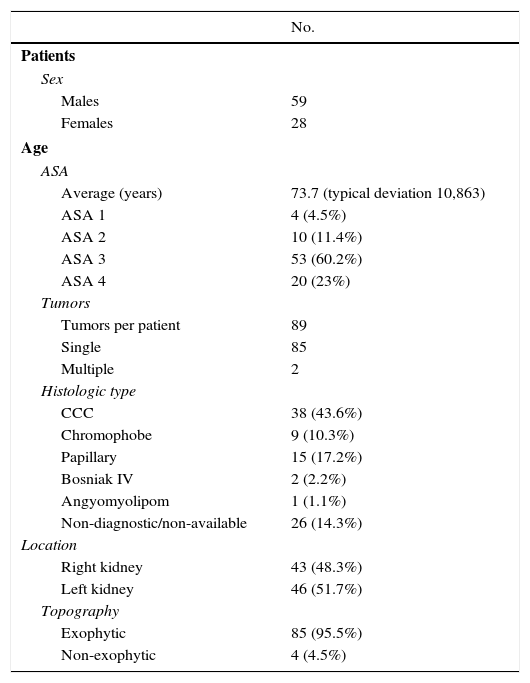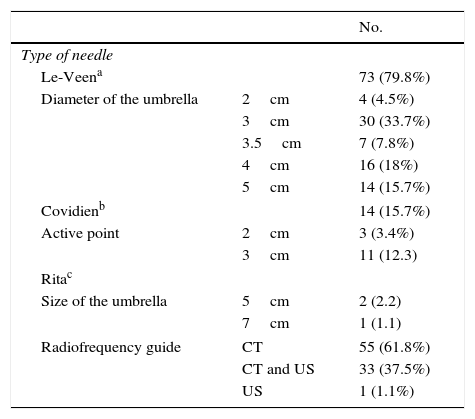To retrospectively evaluate the efficacy and safety of percutaneous radiofrequency ablation (RFA) done to treat renal tumors in patients with high surgical risk or with the risk of developing multiple renal tumors in the medium term at our center over a period of 10 years.
Material and methodsBetween 2005 and 2015, we used RFA to treat 89 T1a or T1b tumors in 87 patients (mean age, 73.7±10.87 years) with high surgical risk. We excluded patients treated with radiofrequency and embolization or microwave ablation. The tumors treated were clear cell carcinomas (43.6%), papillary renal carcinomas (17.2%), chromophobe renal cell carcinomas (10.3%), cystic tumors (2.2%), and an angiomyolipoma (1.1%). The mean size of the tumors was 2.6cm. Computed tomography and/or ultrasonography were used to guide the procedure. We analyzed the relation between the efficacy of the procedure and patients’ age, the type of needle, the source of the patients, the size and location of the tumor, and the number of sessions required to achieve ablation. We recorded all complications.
ResultsThe RFA procedure was completed in all patients. The mean follow-up period was 32.1 months. The efficacy was 93.7%. A single session was sufficient in 87.5% of patients; 8% required two sessions and 4.5% required three sessions. The only factor associated with worse efficacy was the size of the tumor (p=0.03). The rate of complications was 5.6%.
ConclusionsRFA is efficacious and safe, with results comparable to those reported in the literature.
Evaluar retrospectivamente la eficacia y la seguridad de la radiofrecuencia (RF) percutánea para el tratamiento de tumores renales en pacientes de alto riesgo o con riesgo de padecer tumores renales múltiples con un seguimiento a medio plazo a lo largo de un periodo de 10 años.
Material y métodosEntre 2005 y 2015, 87 pacientes (89 tumores) con una media de edad de 73,7 años (desviación estándar: 10,87) con riesgo quirúrgico alto que presentaban tumores renales T1a y T1b fueron tratados mediante RF. Se excluyeron los pacientes sometidos a RF y embolización o ablación con microondas. Se trataron carcinomas de células claras (43,6%), papilares (17,2%), cromófobos (10,3%), tumores quísticos (2,2%) y un angiomiolipoma (1,1%). El tamaño medio de los tumores fue 2,6cm. La tomografía computarizada y/o la ecografía se utilizaron para guiar el procedimiento. Se analizó la relación entre la eficacia y la edad de los pacientes, el tipo de aguja, el origen de los pacientes, el tamaño y localización tumoral, y el número de sesiones necesarias para ablacionar el tumor. Se registraron las complicaciones.
ResultadosLa RF se pudo realizar a todos los pacientes. La media de seguimiento fue de 32,1 meses. La eficacia fue de un 93,7%. El 87,5% de los pacientes requirieron una sola sesión, el 8%, 2 sesiones y el 4,5%, 3 sesiones. El único factor asociado a una menor eficacia fue el tamaño del tumor (p=0,03). La tasa de complicaciones fue del 5,6%.
ConclusionesLa RF es eficaz y segura, con resultados comparables a los referidos en la literatura especializada.













